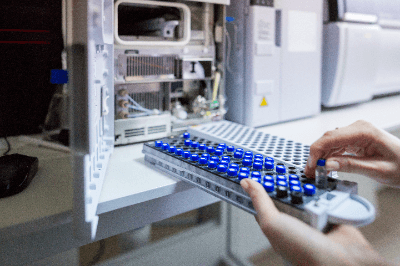What Is HPLC?

HPLC (High-Performance Liquid Chromatography) is a method for separating and detecting individual compounds in a sample through the interaction between a column and the sample. It is highly effective for measuring and detecting trace components and is widely used in industries such as pharmaceuticals, biochemistry, food, and environmental studies.
Since the peak area of HPLC is proportional to the sample concentration, it is possible to quantify the concentration of components in the sample. The separation behavior of samples in HPLC varies depending on the column and mobile phase, requiring the design of appropriate analysis conditions.
How to Use HPLCs and Their Applications
High Performance Liquid Chromatography (HPLCs) are analytical method that utilize the interaction between a column and a sample to separate each component within a sample. The method is straightforward: analysis can be performed by directly injecting the sample solution or by placing the sample solution in the autosampler for batch processing.
HPLCs are utilized in various industries. In the pharmaceutical field, they are used to analyze trace impurities and active ingredients. In the food, beverage, and environmental sectors, they analyze nutritional ingredients, functional components, additives, and pesticide residues. In biochemistry, HPLCs are employed for analyzing proteins and nucleic acid-related substances.
Principles of HPLCs and Columns Used
HPLCs and gas chromatography (GC) are types of chromatography. This method separates compounds contained in an analyte by passing them through a column, allowing adsorption to the column or other media. The medium through which the sample components flow, such as a solvent in HPLCs or gas in GC, is called the “mobile phase,” while the medium to which the sample adsorbs, like a column, is the “stationary phase.”
The type and strength of interaction between the sample components and the column vary depending on the column type. For example, in an ODS column, an alkyl chain (octadecyl group) is bonded to the column, enabling the sample’s adsorption through hydrophobic interaction. Silica gel columns have silanol groups on the surface that adsorb polar compounds. Other column types include those modified with phenyl groups, cyano groups, and amino groups.
Concentration Calculation Using HPLC Peak Area
The peak area of HPLCs is proportional to the concentration of a sample. However, when using a UV detector, the peak area varies with the absorbance coefficient (ease of light absorption), even if the sample concentration is the same. Therefore, when analyzing concentrations using HPLCs, it is necessary to prepare standard samples for area comparison.
One concentration analysis method is the “external standard method”. This involves preparing multiple standard samples with known concentrations for HPLC analysis and determining the peak areas. Since the concentration of each sample is known, an equation for determining concentration from the area value can be obtained by plotting the area value against the concentration.
The second method is the “internal standard method”. Here, another compound, chemically and physically stable, is added as an internal standard to a standard sample with a known concentration. After addition, HPLC analysis is performed to determine the ratio of the standard sample’s peak area to that of the internal standard. A calibration curve can be obtained using the ratio of the added internal standard amount as the abscissa and the peak area ratio as the ordinate.
HPLC Detectors and Limits of Detection
A variety of instruments serve as HPLC detectors, including ultraviolet-visible (UV-Vis) detectors, fluorescence detectors, and differential refractive index detectors (RID). The detection limits of these detectors vary widely depending on the sample. For instance, the UV-Vis detector has a detection limit of approximately 10 picograms (pg), and the fluorescence detector is 0.1 pg.
The most sensitive is the mass spectrometer (MS), estimated to have a detection sensitivity of 0.01 pg. However, the detection limit depends on the type and concentration of compounds in the sample, the degree of separation, and sometimes derivatization. Optimization of HPLC analysis, including sample pretreatment, is necessary for high-sensitivity detection.